| S&TR Home |
| Indoor line |
| Whats new? |
| Links/email |
| Making track |
| Track Plan |
| Photo Index |
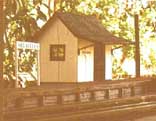 |
 |
Updated Aug 28, 2024 |
This page is a Diary of the Latest Happenings on the railway
Supposedly the connection to the rest of the S&TR
>>>>>>>>>>>>>>> ****************** click here for the video *********
So just to reinterate, there are lower and upper stations, separated 10" vertically, and joined by about 15' of very steep and sharp curved line.
and with tracks reinstalled
****************** click here for the video *********
and all gone...
There is still 100m of mainline to run on. So now the yard looks like this...
****************** click here for the video *********
So I am thinking of a two level layout, end-to-end line which will have a 'station' on each level linked by a line about 5m long. In keeping with the 'history' of the shed as a pottery studio, the railway will connect a clay mine with a pottery factory to provide the traffic on the line as well as some general goods and a small railmotor for passengers.
The layout plan (in progress) looks like this...
To achieve this I needed to
For 2, the circular turnout is 8cm in diameter and will allow up to 8 tracks to be accessed. Looks like this
****************** see this video for a better explanation
for 3 and 4, I made up a semi-circle of 30cm radius (outside rail) with aluminium rail and used my existing #18 loco ("Ugly") and 3 coal hoppers with 100mm wheelbases. I increased the rail gauge to 46.5mm. And it worked! (wagons with longer wheelbases won't go around the curve!)
****************** see this video to see the tests
Front view. Six, AA rechargeable batteries are inside the curved front.
Electronics in long hood include speaker, radio control receiver, motor control and sound.
****************** click here for a video *********
The steering is via a servo driving the chains.
I could not fit in a speaker to provide sound and anyhow, the gearbox noise would probably overwhelm any sound. As there is no sound, I fitted a hurricane lamp to remind me that it is turned on.
I was hoping to make it 'programmable' so that it could 'wander' down Lilyvale's street under it's own control, but it didn't work. I did manage to program it to make a 3-point turn on its own!
click here to see it do its stuff.
I used infrared detectors (IR) type TSOP4136, operating at 36kHz to detect the trains at either end of the single line - these are what are used in TV remotes. They require an IR LED transmitter (Tx) run at 36 kHz and this is provided by a Picaxe 08M2 at each end. Using 36KHz modulation makes them much less susceptible to sunlight although they still can't handle direct sun on the Rx. The transmitter LED is mounted on one side of the track and the receiver on the other. When a train is present, the beam is broken and the Rx output signal goes to +5V.
So this is the arrangement I’ve come up with. The IR transmitting diodes are on the left and the receivers are inside the signal hut, with the rest of the electronics. The signal head is on the wall – they are meant to be visible to operators – not scale train drivers!
And this is the electronics board at the Melaleuca end. The same picaxes are used to do this detection and to 'count' the trains in and out of the single line. This number of trains is sent to the other end on a 2-wire link as 4 different dc voltages, stored on a 100uF capacitor. A maximum of 3 trains can safely occupy the single line, if they are following one another.
Click here for a video of its operation
- - - - - - - - - - - - - - - - - - - - - - - - - - - - - - - - - - - - - - - - - - - - - - - - - - - -
This is the detailed description of the mode of operation.
Take a single line between A and B. There are signals at A and B controlling entry to the single line.
Signals can be either 2-colour light ( red and green where caution is red+green both on) or 3-position semaphore driven by a servo.Trains passing a Stop signal cause an audible alarm.
a) When a train enters the single line at A, the signal at A shows Stop for say 15 seconds, then shows Caution as an indication that a 2nd train is now allowed to follow. It also sends a 'message' to B indicating 'one train in section' which causes the signal at B to show Stop.
b) if the train continues through the section, when it leaves at B, the B signal clears and sends a message to A indication 'no train in section', and that clears the A signal.
c) If a second train follows the first into the section at A, the signal at A again shows Stop for 15s and then Caution. (still allowing for a 3rd train to follow later) but a message is sent to B indicating there are 'two trains in the section'. When the first train reaches B, no signals change, but the message to A indicates only 'one train in section'. When that second train arrives at B, its signal clears and the message to A saying 'no trains' causes A to set its signal clear.
d) if a 3rd train has followed the first two at A, the signal at A shows Stop to indicate no more trains can follow. The message to B indicates 'three (or more) trains in section'.
Actually any number of trains can illegally follow and will be counted in at A and out at B, but the message to B only indicates “3 trains in section”. As the trains arrive at B, the messages 'count down' 3 arriving trains and then clears its signal and sends a ‘no trains’ message to A. This obviously wrong, but should never have got to this point anyhow!
The signal at A reverts to Caution when only 1 or 2 trains are left in the section, and clears when there are no more trains in section. check this
e) whenever a trains passes a stop signal, an alarm sounds at that signal only. (this needs external circuitry as the picaxe has no spare pins) This occurs for either:
f) if a trains shunts onto the unoccupied single line at A, the signal will go to stop for 15 sec and then to Caution, and a ‘1 train in section’ message to B end causes that signal to go to stop also. Then provided that the shunting train cleared the detector, when it 'arrives' back at A again, the A signal clears and the message to B indicates 'no train', so B signal clears.
g) If a shunting train follows another into section at A, but then reverses back out to A (ie shunting onto the section- this is allowed by the Caution signal), the signal goes to Stop for 15sec then back to Caution. The message to B says ‘2 trains in section’. Then provided that the shunting train cleared the detector, when it 'arrives' back at A again, the message to B indicates ' 1 train'. Signal A stays at Caution and signal B at stop.
h) This also happens if the train is a 3rd train doing the shunting – it sets the signal to red and sends ‘3 trains’ message to B. When it shunts back out of the section at A, it is correctly counted out, but the message ‘2 trains’ is sent to B, and the signal at A goes to Caution. The signals will clear when both the trains in section reach B.
i) If there are already 3 trains in the section, and a 4th train illegally shunts onto the section against the stop signal, an alarm sounds. When it shunts out, it confuses the signals as the message can only say ‘3 trains in section’. So when 2 of the 3 ‘legal’ trains in the section reach B, its signal clears and a ‘no trains’ message goes to A and its signal clears, EVEN THOUGH THERE IS STILL A TRAIN IN THE SECTION!
j) If a train is in the section as in a) and b) above, and a train illegally enters the section from B against the stop signal, the message will be sent to A indicating '2 trains in section' (check), but no signals will change. An audible alarm sounds at B. If the train then backs out of the section at B, the message to A will indicate 'one train' and all will work correctly. The signal at B will clear when the through train from A arrives. (Again this depends on the train at B actually clearing the detector when entering the section, so that when it shunts back out, the detector can detect it.)
Here's a video I made illustrating what I want to achieve...... click here
I started off experiments with an ultrasonice device that measures distance using 40kHz sound waves. But finally gave up as it could not detect the small 'frontal area' of small wagons.
Testing continues, but I think I have the picaxe programs working and it just needs building the circuits and testing.
the finished job..
It will now just be a long siding from Sandstone, possibly with some industry like a log loader.
video of closing the line and a video of a logging day using Blackwall
Here's the new plastic sleepered track.
But now after $4000 spent eradicating them, I have been able to repair the wall. Now I can get back to playing trains.
When I pulled it apart, it looked like this..
So I used the similar method I used on the extension back in August 2015, of gluing paddle pop sticks to Corroflute.
I screwed aluminium angle behind this into the vertical supports - back view
front view before installation.
Then the aluminium is screwed to the baseboard. The platform edge planks were nailed and glued to the vert supports.
and backfilled with concrete
The darker wood in this picture is the section built 2 years ago.
Here's the whole station
Now did I leave enough clearance????
more to follow...
In addition, I have found termites in the timber supports.
So a decision has been taken - it will definitely not be repaired.
Now I'll have two 'good' (4' rad) turnouts to use elsewhere and lots of brass rail spare. And two, 2m long steel arch bridges.
As a result, Ti-tree becomes a terminus, so I'll try and fit in a turntable.
Prototype water cranes came in different pipe sizes depending on how much water had to be delivered quickly.
I've still got to get my wife to sew some more trunks - I did these with superglue.
This is the new track at the north end. There is still one swivelling turnout. The siding on the right will be the wheat silo siding.
This is the view from the south, comparing old (left) and new (right)
The old and new plans
The smokebox is from a Bachmann Big Hauler, with on/off switch behind the door.
I used Hobbyking Rx and ESC, but used a picaxe for the direction control via a relay and the sound.
There's also a Directors Cut version with different scenes I had the whole track open - probably for one of the last times. There are many rotten support posts, Ti-tree station is rotting away, the track is falling apart in places and the swivelling turnouts are falling apart too. I held them together for the day with lots of glue and the min number of nails.
I had a spare motor block from a Hartland Mack loco. I screwed a 1mm piece of steel under the motor block and then made the baseplate from 2mm styrene. As there is only 5mm clearance from rail, I connected a temp battery and ran it around the layout to check clearances at grade changes.
The difficult part of the build is the rounded corners of the body. I made the body from 2mm styrene and then reinforced the internal corners with 6x6mm wood.
Then I rounded the outline using my bench grinder.
Then used my usual method of applying the rivet detail, by wrapping embossed 0.5mm styrene cladding, around the corners.
This shows some of the cladding applied to the cab.
I reused a smokebox and cab roof from an old Bachmann Big Hauler. This pic is before I did the rounded edges.
The cab floor was the only place I could fit a speaker - it will be covered with black cloth. This pic also shows the box around the motor block. All the visible space around it and 20mm on top of the box, is available for batteries, Rx, ESC and sound board. I'll be using Hobbyking RC and 8, AA NiMH, 2400 mAh batteries.
The real loco had a void for about half the length of the boiler, behind the high sides. I chose not to model this as I would not have had enough room for all the batteries and RC - the Mack motor is quite high and restricts space above it. (this pic from a great model on the internet - sorry I cannot remember where it's from to acknowledge it.)
................
Way back in 1997 I made my first powered scratchbuilt model - a railmotor based on the QR original Gulflander.
It was made from plywood and a motor driving the axle via a rubber band. It was track powered.
Over the years I have added a 'magic wand' control using magnets and a simple sound system ( see OLD video here ) but I was never happy with it as it ran too fast and had no speed control, so it has mainly sat on ther shelf.
So click here to see it run now ... 'just for old times sake'
By the way, way back in the early days, it took part in some club drag races in it's dragster guise. For the races, I replaced the 12V motor with 3V, which gave super speed and blew the competition away. The motor only lasted just long enough before it burnt out too!
LATER ... I've now found that the 6 adjacent posts are also rotten.
Colours chosen by grandson Eddie. The unit with the nameplate 'Eddie' is a dummy and just carries the batteries. The other unit uses the usual Mack motor and contains the RC receiver and speed control electronics and sound.
click here for a video
Here's what the original looks like, ............................. and my attempt so far. I will then have enough space for radio control and sound.
and this shows the finished track. The track into the tunnel can be used as another Lilyvale siding.
This plan shows the overall layout around Lilyvale and Maple Jn. The new track allows trains to cross at Lilyvale and return to Melaleuca directly.
The Bachmann motor block was getting jerky and I had already replaced the split gear on the axle. So a year ago I bought 3 new motor chassis from Bachmann, one was the Anniversary version with the metal valve gear. I finally got around to using it to replace the old one in #2.
I still have plans to rebuild the body, but at this time I just gave it a quick overhaul... a new led headlight, new lettering on the tender (done on my home printer), raising the tender floor to match the cab floor, and a good wash !
The building has a rear awning (held on by magnets)
This required an extension of the front platform too. I've used paddle pop sticks glued to corroflute.
Added servo control to the third signal at Melaleuca. Servo is housed in the small cabinet.
The Railway Hotel has had a facelift.
The Melaleuca signal box has also been repainted and had new windows fitted.
No24 at a well populated Melaleuca station
A busy day on Main Street Lilyvale
at Sandstone
BUT does it need a cowcatcher??
I used Hobbyking RC and ESC, mounted in the boiler (smokebox door pulls off).
In the tender there are two, 1000mAh LiPo batteries and a picaxe sound board and speaker.
Has Hobbyking RC (in boiler) and batteries and Picaxe sound in tender.
I had a USA Trains diesel block and a spare old Bachmann Big Hauler with nice big wheels.
So I decided to transfer the wheels to the 'diesel' block. I had to use brass tube shims to match the axles and wheel sizes.
To support the body, I screwed a bent alum bar to the top.
The baseplate is 2.5mm styrene
The front pony truck is a couple of alum angles and a big hunk of lead, swivelling on a bar.
Here's the bits needed (Tx not shown). I used only six NiMH LS cells to keep the max speed down.
The 3 main bits were hot-glued together and 'stuffed' into the boiler. The batteries are in the side tank and the speaker in the floor of the cab, covered by a piece of black material.
I built the simplest possible sound system from a Picaxe 08M. Not even and amplifier - just a transistor driving the speaker. It provides a quiet hiss when stopped and louder chuff when running.
And even though I dislike bells on trains I added one here to fill the hole where the on/off switch was originally located! Here's a short video of the sound
I had to add an operating link to operate the points I could no longer reach.
I used 4 wheels to support the ends. The centre is just a pivot/axle.
Here's Nick at Beeston Market waving the flags
This is Rik and me posing for the photographer:
Just one of Rik's beaut scratchbuilt locos (see the videos later for more pics)
And I visited Paul Holt's 'Linz Gstadt Bahn' in Wales (Paul is pure LGB!)
Rik's GR video
My GR video
And my video of the 'Little Trains of Wales".
The fire has the 5 LEDs, with bits of aluminium foil ‘scrunched around them and then some red cellophane also scrunched around. The wood is real twigs, burnt in a candle flame.
I used polyclay to makes the rocks around the fire and the axe.
I started with a sitting figure holding a brief case. I cut the briefcase away and sliced off both arms at the shoulder.
I pivoted the right arm at the shoulder with a small screw. I cut the right hand off and rotated it to hold the mug made from a piece of plastic tube. The right arm is operated but a thin rod recessed into his coat, under his arm.
click here for a video of the movement and fire effect
I've been adding RC control to my little railcar 'Nick'. Used a keyfob type RC and a single Picaxe to do the motor control and a diesel engine sound with gear changes.
Here's a short video
And as a sideline, I've been making a few hurricane lamps, from some plastic beads I found in a craft shop and other bits and pieces. I've also written a series of 'tutorials' on how to use Picaxe.
Also a video of some night running.
The flickering firebox effect is something else I have been working on. It uses a picaxe to drive 4 LEDs in a random manner.
I've fitted fluorescent lights !
And am experimenting with folded paper, concertina corridor connections between carriages.
******** CLICK HERE FOR A VIDEO OF THEM. !!!
The inside walls long view of the buffet counter before wall added Bacon and eggs for two! The plates are punched from thick aluminium foil. coffee for the ladies. The mugs are 3mm styrene tube. I even made a tiny fork....... I've cut out all the windows: Since the existing cars don't have end doors modeled, I'll experiment with adding concertina diaphragms between cars. This one is just a paper mock-up - it needs to be taller. And with a bit of luck it will ultimately have a smoke generator with frying bacon smells!!!
The most recent changes are at the top. Plenty of pictures down the page!
click here diaries before 2013
Feb 2, 2023
Work continues on the scenery on the indoor Claymine Branch. This is the rotating turnout on the upper level.
the first bit of scenery. I am using pine bark to create the layered rocks...
Jan 2023
These webpages are spread over the free Trainweb.org and my ISP (Optus). Optus decided to change their web address system a few months back, with the result that I had to change the code in most of my web pages. I still am not sure I have all the links fixed. And they changed their method of ftp for uploading the files. Fixing all these problems has taken ages.
Dec 2022
The garden has been overgrown with all the rain in Sydney last year, but I have now got it running again. But there are major maintenance problems and I am not sure how long some of the track will continue to be serviceable without major re-sleepering.
Oct 2022
I finally got to start on the indoor line. (see June 2019 entry). After Pauline died I needed a diversion, so I ripped out the shelves we had built for all her pottery equipment, gave away her wheel and all her clays and glazes and started building as per the plan.

I have finished the baseboard construction and laid the track using mainly 'toy train' plastic track. The circular, rotating turnouts work OK and I have about 6 small locos that can negotiate the nominal 12" diameter curve. At one section the inner rail is only 8.5" radius! And the steepest grade is 1:11 on a 15" radius !
In memory pf Pauline I have decided to call the indoor line the "Claymine" branch of the S&TR. The two stations will be Claymine (upper level), where clay is loaded onto wagons, and Pottsville (lower level) where the there will be a large pottery factory to use the clay. Short station platforms will allow a passenger service.
Now for scenery !
February 2022
My latest loco construction. A 'baby' Heisler type. I don't think there is a prototype - I copied from another model. I made it to run on the future indoor line and named it after the town where my family's weekender is.
October 2021
Termites again! Termites had eaten out a whole wall of the train room and the whole of the baseboard where I store my trains. So it was a complete rebuild, during Covid, with timber shortages. Luckily my grandsons came to help. This time I have used all termite resistant timber.
The new baseboard...
March 2021
A swimming pool car !
I thought that patrons of the Sandstone Expresses might enjoy a swim on their journey so I took a centre well wagon and added a pool and it became the "Oasis" car. Yes it has real water.
October, 2019
Ti-Tree closure and demolish.
Due to continuing damage by neighbour's tree dropping branches, I decided to remove the whole of the around-the-yard line including the big raised baseboard of Ti-tree station.
This is how it was...
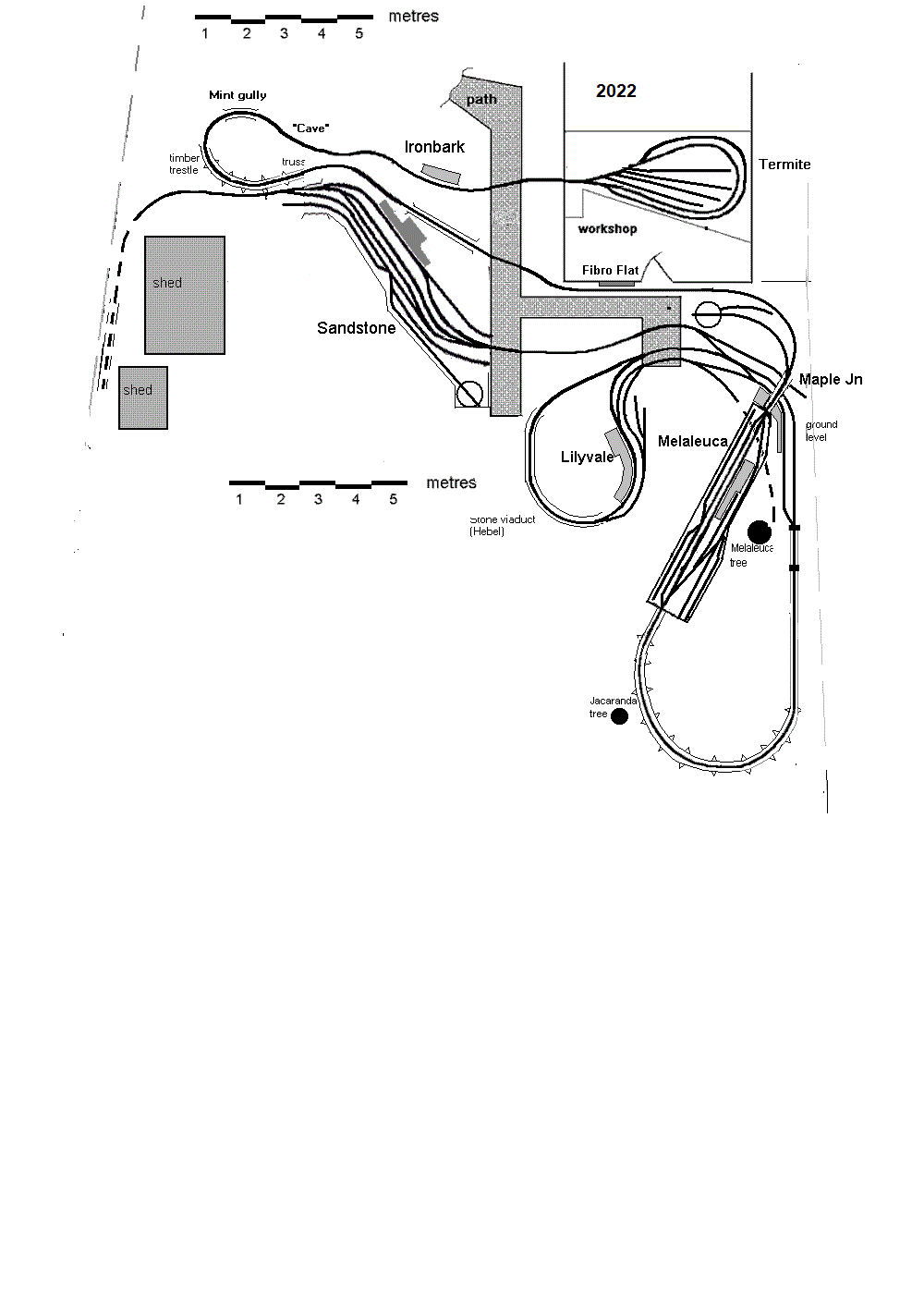
June, 2019
I have started thinking about building a small indoor G scale line in my wife's old pottery studio.
I have a L-shaped space about 2m along one wall by 2.7m along the other and can be around 50cm wide.
1. use small trains no more than 60cm long with small locos 8cm long (which I have on the garden line)
2. 'invent' a 'circular' turnout to save the space of multiple turnouts,
3. be able to negotiate a 30cm radius ( ie 12 inch) semi-circular curve on a 1:16 grade,
4. climb a 1:12 grade on a 60cm radius curve
So it looks like it will be feasible!!!
March 4, 2019
I finished the push-up loco. Painted it green and cream as I couldn't find a suitable light green for the cab. Side view.
February 2019
I started work on building a new 'push-up' loco. Based on a Hartland Mack chassis/motor block.
I want a small loco with basic RC to allow me to 'bank' trains up the 1:25 grade. After much procrastination, I decided on a weird looking loco.
June, 2018
A friend offered to bring his drone around and take some videos of the railway from above.
So here's a couple of videos of the results of his flying in amongst my trees! Thanks Glenn.
The first one makes no attempt to hide the sheds, house or people.
this one is meant to be a 'documentary' on how a helicopter (not a drone!) was used.
May 6, 2018
I decided to make a radio controlled road Traction Engine. I used a Tamiya motor / gearbox to get the speed slow enough to be realistic. The wheels came from another static model (Thanks Rik.) The rest is scratchbuilt using styrene. The motor is only 6V so I used just four, AAA NiMH cells (under the driver's floor). It still only requires about 2.5V for a realistic slow speed.
The radio control is in the boiler - accessed by removing smokebox door. There are 3 controls, using my usual Hobbyking 2.4GHz system and Picaxe controller - forward/reverse, speed and steering.
April 25, 2018
I've completed a single line automatic signalling system between Melaleuca and Termite.
The problem was to detect a train entering or leaving a single line section and operate the appropriate signals (semaphore or colour light) at both ends of the single line, to stop opposing trains colliding. It should also allow trains to follow one another through a section.
To detect the direction a train is travelling, I use two IR detectors spaced about 100mm apart, at each end. The order in which each detector detects, shows the train direction. The 100mm is determined to be less than my shortest loco.
This is the basic arrangement I use. It’s meant to slide under existing track between the sleepers. I housed the Rx electronics (picaxe etc.) in a styrene sig hut and the IR beam angles upwards so the Rx never 'sees' the sun.
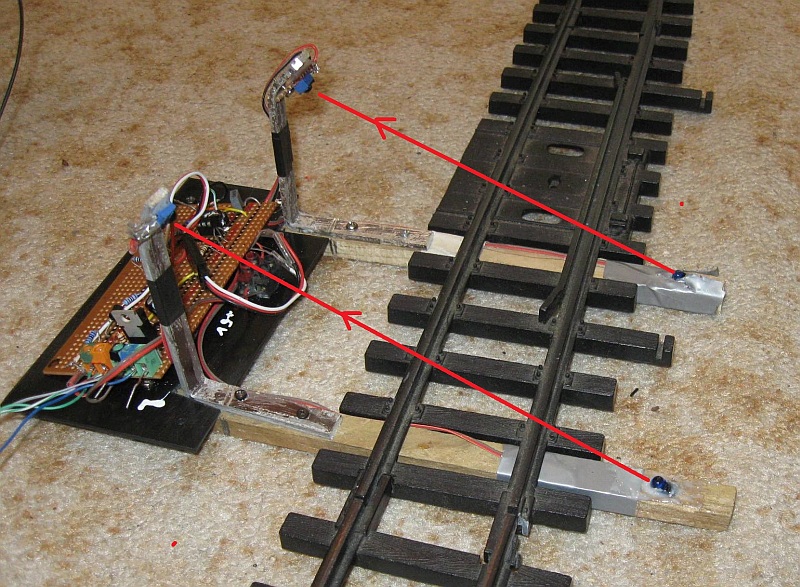
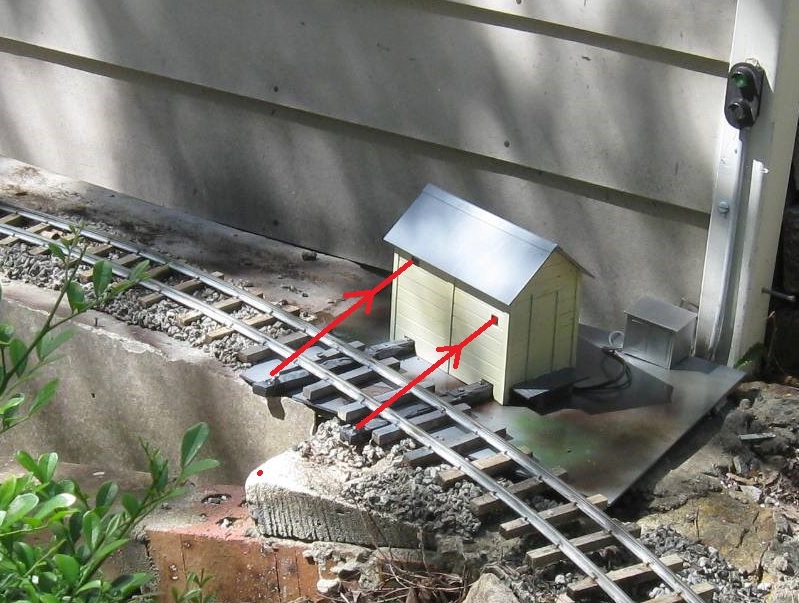
I used 10mm dia red and green leds mounted in a styrene signal head on the house wall. The green led is high intensity, (9000 mcd) has 3.0V @ 20mA and the red one, 2.3V. I ground the round head off the leds to make them flat.
It is written for trains going from A to B, but all of this applies equally for trains in the opposite direction.
Up to 3 trains are be able to follow one another through the section – ie like a 'divisible staff'. (why did I choose 3? - I really only want to allow 2 trains to run through, but I want a 3rd to be able to shunt onto the section and out again at the same end, and for the signals to still work.)
* entering from the wrong end onto an occupied section, or
* a 4th or more following/shunting train entering from one end, or
* a following/shunting train entering the section from one end, while the 15s timer is active (see a).
Feb 25, 2018
I've spent the last 2 months wrestling with designing a signalling system to protect a single line.
The goal is to have signals at each end of a single line, that allow trains to follow one another and to display a Stop signal at the other end. It will use Picaxe microcontrollers at each end to do the signals logic. It is necessary to determine the direction which trains are travelling, and I do this by having two detectors about 100mm apart. The order in which a train passes them tells the direction! The picaxe program also does this logic.
Then I tried using infrared beams REFLECTED from the sides of trains, hoping that I could keep all the electronics on one side of the track.
It proved a bit unreliable with small, low wagons, so I have finally gone back to the method I have preciously used for train detection - putting the IR beam across the track and letting the train break the beam. I have used this method before to control turnouts, but it was always a bit hard to make sure the sunlight didn't interfere. Now I have used small devices that can detect the infrared beam modulated at 36 kHz, so much more tolerant of sunlight.
Feb 20, 2018
The elevated turntable at Melaleuca was made in using tomato stakes driven into the dirt. They finally rotted away so I replaced the 'legs' with plastic elec conduit. The top pic is the original.
Nov 16, 2017
While lopping the tree over the big rock ledge, one of the branches bounced and damaged one trestle leg.
So I made a short video of using the crane to repair it.
click here
Nov 14, 2017
I converted an old boxcar shell into a stationary workmen's van / shed
Here's what I started with - a 'toy' boxcar, that I had used bit from for other projects.
Oct 7, 2017
Further to track damage at Blackwall ( see March 2017), I removed the crossing loop and station from Blackwall
Sept 24, 2017
I had to replace the rotting sleepers on the siding through Sandstone goods shed. I had experimented with using old fence palings as sleepers but they didn't last as well as treated pine. They were laid in March 2010, so only lasted 7 years.
Sept 24, 2017
Back in March I discovered that termites had eaten a number of wall studs in the trains room.
(Well, I did call it 'TERMITE"). Here's some of the damage
Sept 14, 2017
I made a short video of the details of my passenger carriages.
here's the link to a video to hear it
Sept 9, 2017
I have rebuit the timber front of Melaleuca station. I last rebuilt it in 2002 and it had rotted (or termites?) like this
This will keep the concrete of the platform away from the timber and hopefully will last better.
August 25, 2017
The new hebel house is complete.
August 19, 2017
A new house made from Hebel is underway.
April 10, 2017
I started taking the track up from the branch-damaged section near Ti-tree and the bridge fell apart.
Mar 25, 2017
I built a new sound system for loco#5 - the 19 class 0-6-0, using the standard white noise and modulator diode circuit that is the 'BEST' in my opinion.
here's the link to a video to hear it
Mar 16, 2017 .. LINE CLOSURE.
Back on 2nd Feb I mentioned the likelihood of closing the section of track between Titree, Blackwall and Sandstone. Well, the GR gods have decided. A neighbour's tree dropped a branch onto the track, destroying about 2m. This is the track where I laid the rail onto fence palings (without sleepers)and was already needing a lot of maintenance after 15 years.
And I have too much maintenance to do on the rest of the line. (repair platforms at both Melaleuca and Ti-tree, repair broken baseboard at Ti-tree, repair crib fencing at Maple Jn, replace lifting bridge across train room door, and biggest of all, repair termite damage in train room!)
The last trains ran through Blackwall on 7th January 2017.
Feb 20, 2017
I've been working on a 2-wheel trailer, based on an Irish railways picture I found.
It can go behind my old railmotor RM2 or as a work van.
Feb 10, 2017
I decided to make a few more water cranes for my steam locos. I made a couple years ago from garden irrigation pipe and fittings.
Naturally, they don't make all those fittings anymore. But I bought a few types as here..
So I decided to use both the 12mm and 18mm pipe sizes. I came up with 3 arrangements as shown here:
Feb 9, 2017
I found a problem with the LGFB R1 points - they are undergauge, as low as 44.0mm. I would have thought that LGB would have gauge-widened on such sharp readius.
Anyhow I too my angle grinder to them (cerafully!) and ground the rail heads to give min 45mm.
I also glue a piece of 0.5mm styrene on the check rails to keep the wheels further over from the 'point'.
Feb 2, 2017
After much procrastination I decided NOT to rip up Ti-tree. I checked all the posts in ground are OK. I MAY still remove the track along the fence from Ti-tree to Sandstone as there are 5 rotten posts and most of the track is on palings and is rotting too.
So I decided to replace the swivelling turnouts and rearrange the tracks.
The new layout uses some 600mm rad turnouts (R1) so I hope most locos will be able to negotiate them.
There is now a 4th loop and 3 sidings.
Nov 15, 2016
Final pictures of Joshua.
Nov 1, 2016 ..... see Sept 26 entry for the start of the build.
After much trouble with the painting,the new Joshua loco is nearly finished. Just waiting for the lettering and names and maybe a bit more detail on the boiler.
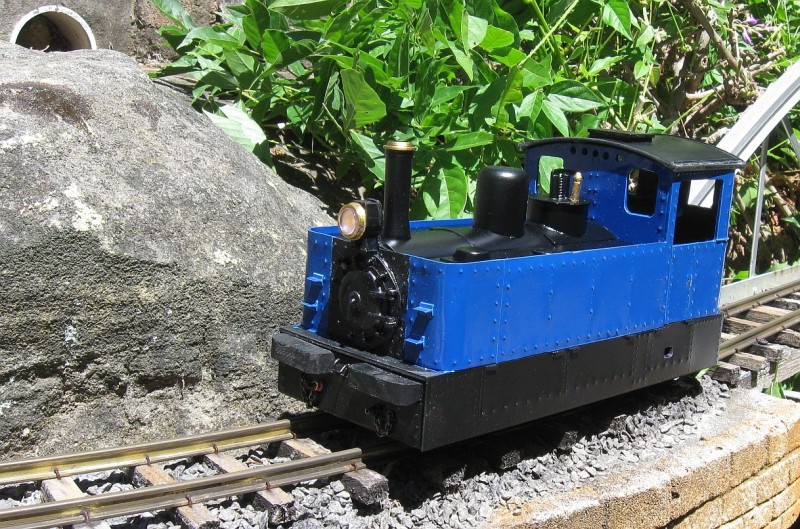
The battery charger leads clip onto the chains on the buffer beam
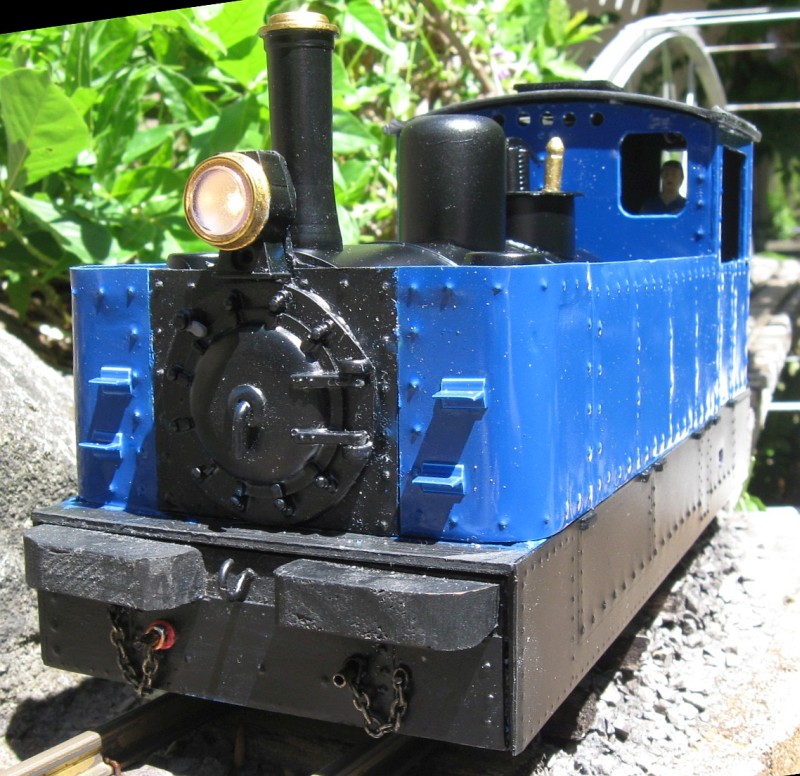
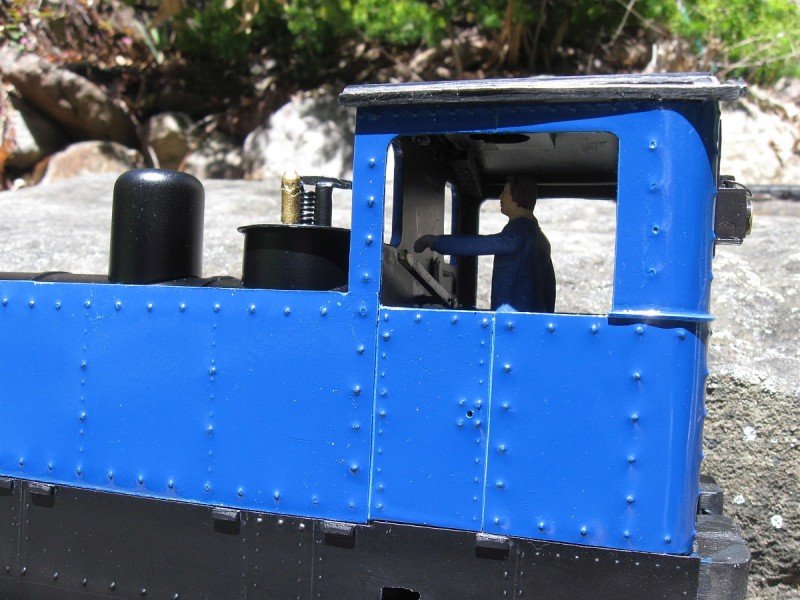
Using a relay for direction, means I can program it to change direction only when stopped - useful for small grandsons!
The eight, 2400 mAh, NiMH batteries are under the circuit board.
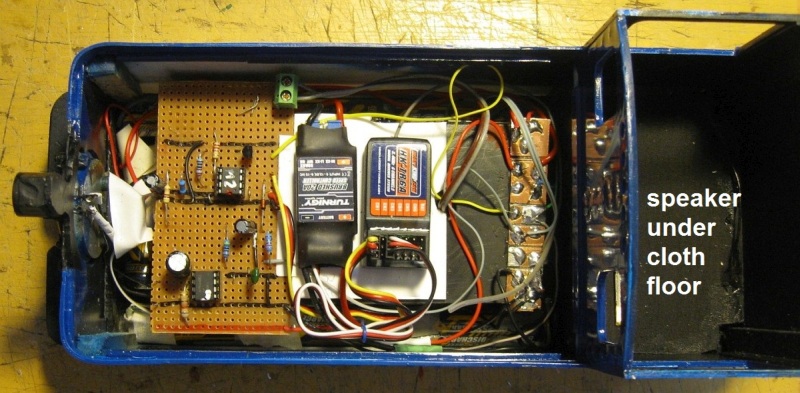
Oct 8, 2016
Today was the BIG coal move day. Keith and Mark and Geof all brought their coal trains and we ran many trains, in very windy conditions.
here's the link to the 10 minute video
At the end of this one you can see Geof's whole train blown off the tracks. It was time to pack up then.
Sept 26, 2016
I've started on building another loco. This time for grandson Josh. He already has a small manual control diesel, but he wants a radio controlled one. So with his agreement, I've chosen this small Glyn Valley Tramway loco. I didn't have a motor block with steam wheels, only a diesel block, so I needed a model that hid the wheels.
As always, it won't be an exact model - I just use it as a guide.
July 11, 2016
The Post Office is complete and installed at Lilyvale. (It's where the Hall used to sit - it will need a new location.)
July 1, 2016
I've decided to make a 'substantial' Post Office building for Lilyvale. It's made from a 200x200x600 block of Hebel.
Progress so far...
June 8, 2016
I have made another shop for Lilyvale, from a wine cask box and some corroflute.
While it is not a very good model, because of its nostalgic value, I wanted to get it working again,so recently I found a 3V motor gearbox in my junk box and decided to remotor it. After all the work installing it and RC, I found it didn't have enough power.
Then luckily Keith gave me a 12V HO motor and worm gearbox. A quick test with a battery showed that it had the power and would get along at 35 kph - just right.
So I remotored it again, added new wheels, added a new Hobbyking RC, a 3S LiPo battery and simple Picaxe sound. It's a super simple control vehicle, with manual reverse.
The speaker is on the rear wall hidden behing some cream material (old handkerchief).
May 23, 2016
One of the posts supporting Blackwall had rotted away allowing the station baseboard to sag badly.
It was too heavy for me to lift up so I drilled a hole through the post and put a steel bar through it to allow me to lever it up and support it at the correct height.
I then concreted the post in place. Hopefully it will last another 15 years.
I am beginning to think I'll just close the line from Ti-tree to Sandstone altogether.
May 1, 2016
I've updated the Locos Gallery page with latest pics of locos and links to videos of locos.
click here for Loco Gallery
The 'double Mack' loco is just about finished.
speed control and diesel sound done with Picaxe controllers.
April 7, 2016
I bought 3 Hartland "Mack" locos last year, mainly for the motor blocks. So I decided to bash one into something different, without too much work.
I'm thinking of making a dummy unit, to make it double-ended, like this
April 2, 2016
I decided it was time to make some 'match' trucks to allow coupling between my chain and hook types and visitors'.
So Keith mounted a Kadee knuckle on one of my 4-wheel wagons for me, and I found another Kadee in my junk box so I mounted it too.
I had a few Bachmann knuckles, and found they seem to mate with the Kadees OK. The normal Bachmann mounting is about 8mm lower than the Kadees. I've mounted these Bachmanns on two more wagons to match the Kadees - bogie wagons this time.
March 13, 2016
After a long rest from trains, I decided to add a 'cutoff' track to allow better use of Lilyvale crossing loop and sidings.
this is the 'before' pic with the wood showing the proposed track.
(The crossing loop at Lilyvale was only used for trains from Oleander and Ti-tree.)
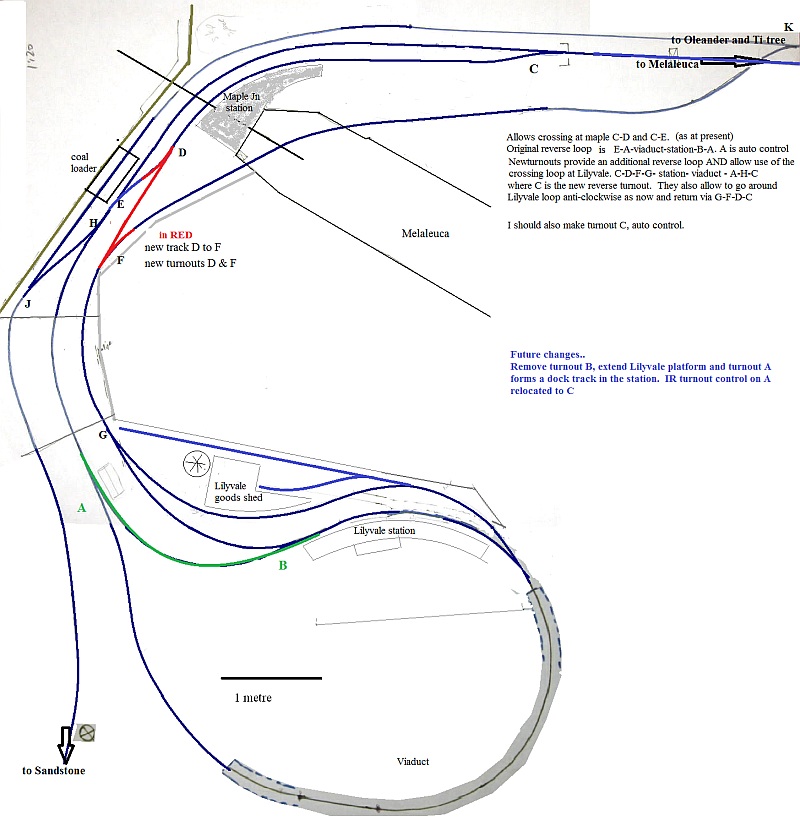
Oct 22, 2015
I replaced the Bachmann sound in loco 2 with my Picaxe version.
Here's video of how loco 2 has changed over the years.
click here
Oct 10, 2015
Loco #2 was my first scratchbuild, way back in 1997, based on a Bachamnn Big Hauler.
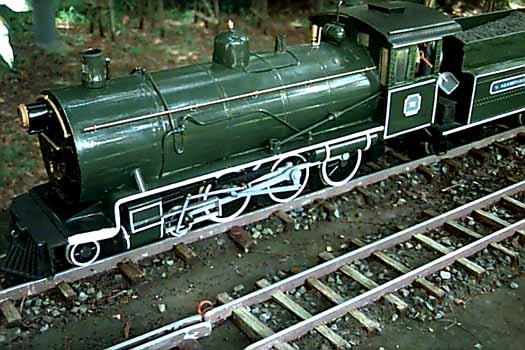
It was pretty easy, just cutting back some of the boiler on the chassis. I painted the wheels black and fitted disk wheels on the front bogie instead of spoked. A bit of dry-brushing to tone down the shiny rods nad levers and a good oiling.
Sept 19, 2015
I updated many of my webpages, including:
Electronics - 433MHz keyfob and 2.4GHz pages
The 'Clickable map'
the Description page
Home page
Links
video link (under Photo Index)
Sept 15, 2015
I added remote control to the two turnouts at the right end of Melaleuca, so I can sit at the other end and control crossings of trains without walking! (bottom right of pic)
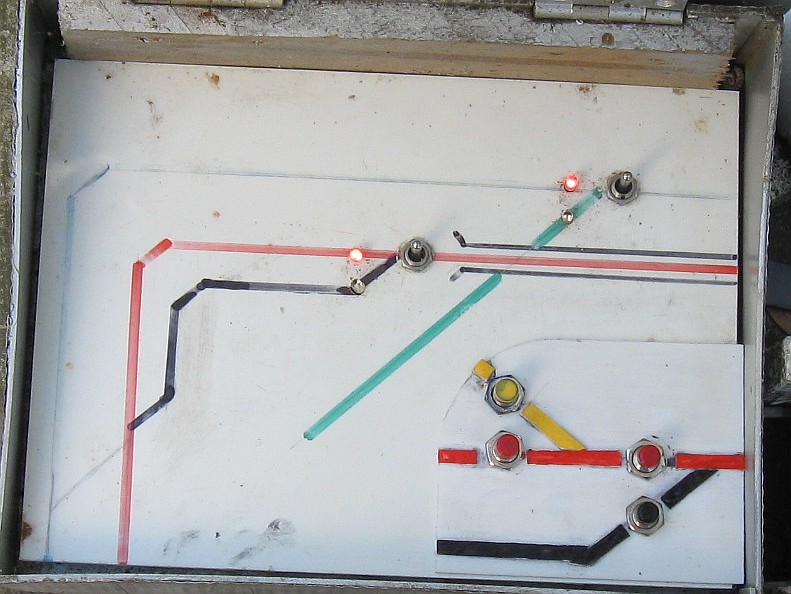
Sept 10, 2015
Here's the final station.
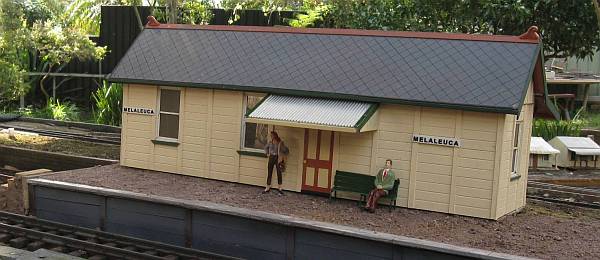
Sept 9, 2015
I was playing around with comparing a prototype pic with one I could take of my model. Here's a pic of Tumbarumba and my equivalent
August 31, 2015
The new back platform is finished using simulated precast concrete. The platform is decomposed granite mixed with sand-cement and brown oxide, to give a rough surface. I also 'mashed' some moss into the surface. Now the building needs a back door!
(The old timber face on the right is rotten and needs replacing too)
August 25, 2015
Started work on building a 'back platform' at Melaleuca. Using rails with styrene infill to represent precast concrete.
August 23, 2015
Experimenting with mixing cheap fence paint (water-based) with soil. Seems to work.
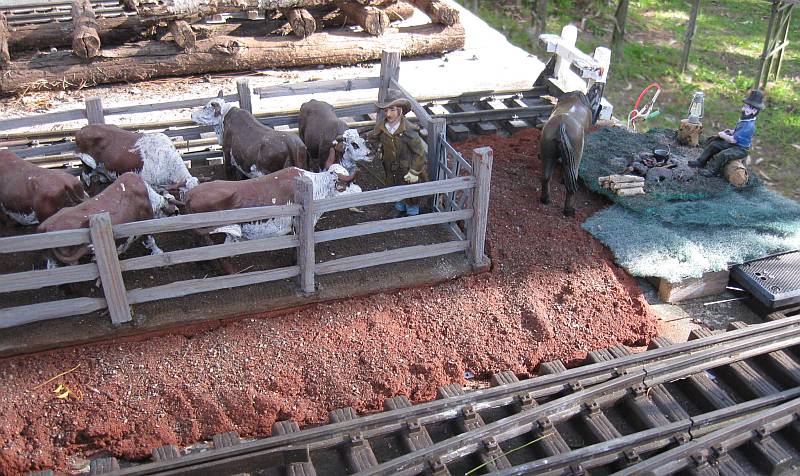
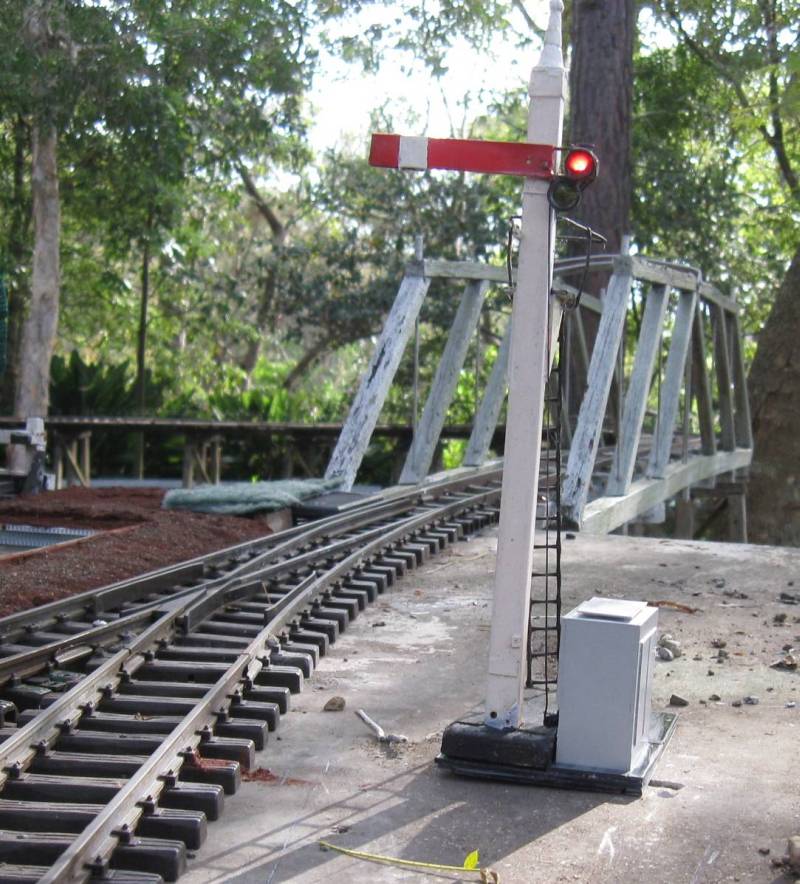
August 20, 2015
I've built some more shelves to hold wagons, and to hold some 'junk', freeing up loco storage space.
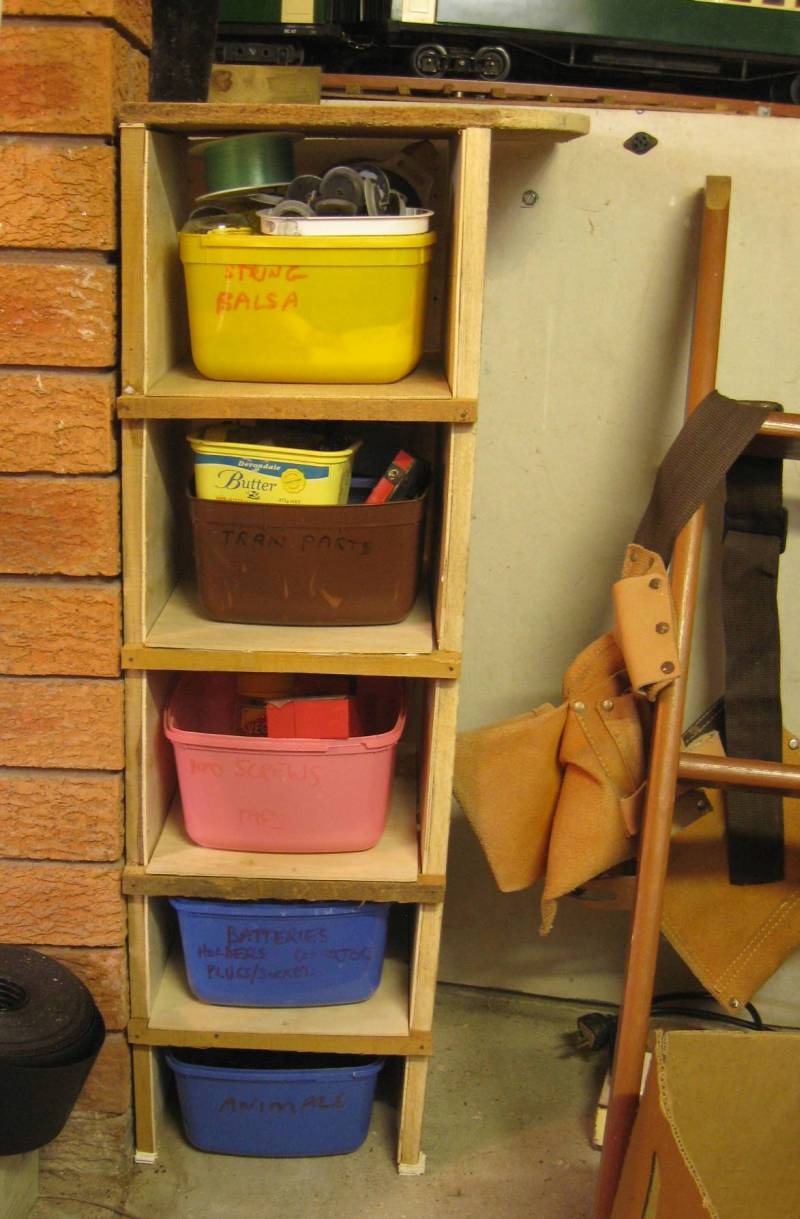

August 16, 2015
After leveling the baseboard, I replaced most of the aluminium track and swivelling turnouts, with some from Bryan's.

August 15, 2015
Melaleuca baseboard had developed a 'hump' due to the legs being pushed up by tree roots. So I cut out a portion and rejoined with aluminium brackets.
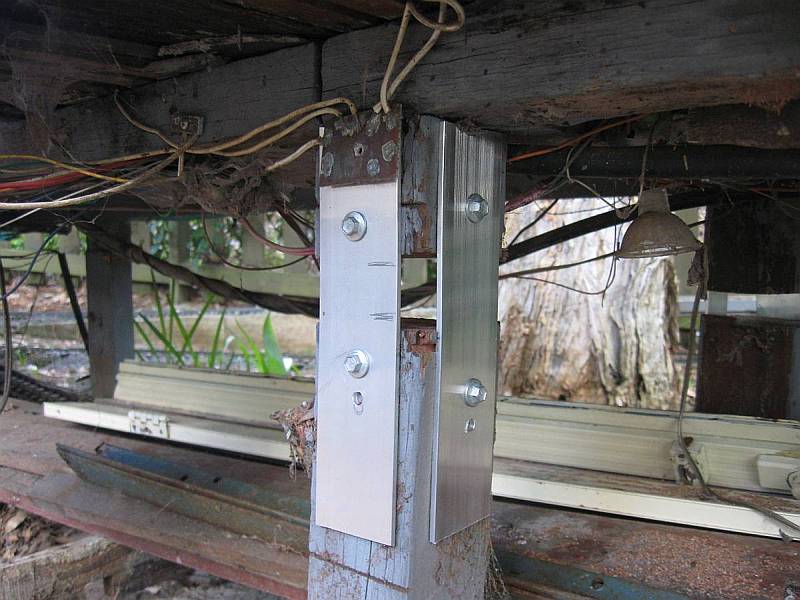
July 16, 2015
I've been resurfacing the 'rubber' road at Lilyvale with old lino tiles (glued upside down over the rubber).
The 'gravel' edges are decomposed granite (used for paths) mixed with cheap brown fence paint. The 'grass' is the same mixed with green fence paint.
The entrance to the station has been upgraded to include a ramp, with more direct access to the pub
July 16, 2015
A fun day running train yesterday, with Lexie and Josh. All the buildings, people and cars were out!
No24 takes water at Ti-tree
July 10, 2015
The 4-4-0 is finally finished, with lining and lettering.
Here is a video to show off the sound....
CLICK HERE
June 7, 2015
Finally the loco starts to take shape.
Here it is out for a test run, still held together with blue tack. A few details and lining to be added.
Apr 12, 2015
I want to build a 4 coupled loco.
After much searching and deliberation, I decided on a loco like this:
I cut down the Bachmann connecting rod. Here's the finished work.
The boiler is 56mm OD elec conduit.
Apr 12, 2015
I decided to convert my grand-daughter's "Lexie" loco from manual control to RC, using Hobbyking gear.
March 12, 2015
I added a couple of goods sidings at Lilyvale. Had to add an 'outrigger' to the front of the conc blocks.
Feb 22, 2015
I have made a 10 minute video showing the stages of construction of the line, starting 20 years ago.
Feb 16, 2015
The turntable is all finished with partial Hebel walls and buffer stop. I didn't make complete walls as the pit would have collected leaves and dirt. This way I can blow or brush them out.
Feb 8, 2015
Concrete poured and some Hebel cut for pit walls.
Feb 2, 2015
Some more work on the turntable - ready to pour the concrete.
The new track which will lead to the turntable
new turnout
Jan 15, 2015
I've decided to rebuild the turntable at Sandstone.
Way back in 1995, I built my first turntable at a station then called Ghost Gum. (Later I changed its name to Sandstone.) It was a concrete base with an aluminium rail for providing power to the rails on the turntable. It was manually turned. I even provided water drainage from the centre!
BUT I made a big mistake. The turntable connected directly to the platform road (because there was no other option). This meant that I could not use the TT when the platform was occupied. And the TT was hard to reach, being at the back.
So I finally decided the TT had to go and I just covered it up and built a goods shed on the site.
But now I’ve decided to build an ‘extension’ at the front of the raised garden.
I've cut some of the rock wall down to level and laid a bit of concrete as a Datum level to work from. The bridge part is finished.
I've decided to make the TT base from (suspended ) concrete – the TT is adjacent to the ramp/path just at the right height for the grandsons to step onto. So I want it strong. I had some corrugated fiberglass roofing lying around so will use it as the base for the concrete.
Nov 15, 2014
I took my railcar 'Nick' to the UK to visit Rik Bennett's Peckforton Light Railway.
For more info on Rik's great garden railway click here
****************************Here's the links to some videos:
Sept 9, 2014
I have completed an animation scene of a fettler sitting on a log outside his tent, poking the campfire and drinking a mug of tea.
It's all done with a picaxe controller, 2 servos, and 5 leds.
The Picaxe 08M2 controls 2 servos and 2 ‘warm white’ LEDs. There are also 2 red LEDs, on all the time, and a flickering yellow LED, on all the time. These are powered directly from the battery.
The time intervals between each drink and the time between each ‘poke’ of the fire are ‘random’, but around 20sec. The number of ‘pokes’ each time is also random, from 2 to 5.
While poking the fire, the drinking is disabled and while drinking, the poking is disabled.
When the fire is poked, two white LEDs are flashed randomly to simulate the fire ‘flaring up’. The flaring continues for 3 secs after the poking stops.
At other times the two constant red LEDs simulate the coals and a flickering ‘tealight’ LED and one of the other LEDs is lit at ¼ brightness to provide some flicker.
The left arm is pivoted at the shoulder and elbow. I had to make the forearm & hand from polyclay so I could get the correct angle for rotation. (the upper and lower arm have to overlap for the screw pivot). Movement is caused by the ‘poking stick’ pushing the arm. The stick is just a piece of brass wire.
Sept 2, 2014
I added the 3rd servo signal at Melaleuca.
Aug 5, 2014
I've installed another signal at Melaleuca. This one is operated by a servo motor controlled by Picaxe and has a bouncing effect.
see video here
click here
May 18, 2014
Grandson Ernie, had his Hogwart's express engine running today.
May 10, 2014
Track relaying is complete. The steel arch bridge and timber truss have been repainted. Still as good as new after 20 years! The timber trestle footing have been replaced and the whole thing painted with clear varnish. Track has been levelled, but no ballasting until I check all clearances. The track under the cave was very difficult to do, especially getting clearance in the tunnel section.
I had to cut some more rock away - obviously the track had 5mm moved from before!
May 1, 2014
I've made a video of how I make my track, nailing brass rail to timber sleepers.
here's the link
April 30, 2014
I've been preparing a set of 6 'tutorials' on how to use Picaxe micro-controllers for Garden railways. They are in pdf format and start with simple programs to make steam and diesel sounds progressing to complicated loco control and control of servos.
here's the link to the webpage which has all the individual links
April 23, 2014
I've started building 20m of brass track to replace the last main line aluminium, on the rock ledge.
I've finished cutting the 250 sleepers and putting in the 1000 nails and have about 4m of track done so far.
This is the area being replaced. It will involve some repair work on the trestle and guard rails too.
April 13, 2014
I bought some more cheap people from eBay. Previously I had tried softening the plastic over a candle so I could move the poses. This time I tried just putting them in boiling water - and it worked! The arms and legs can be gently bent to different shapes. I also tried putting them in the oven at 120C (polyclay baking temperature) and it didn't melt them. But the boiling water is easier to use.
Mar 21, 2014
I had a failure of lettering. I usually have made my wagon lettering by just printing on plain paper. But for the PB15 I decided to use glossy photo paper. I glued it all on but after a week I noticed that the black was bleeding thtough into the white lines, so I had to rip it all off. I experimented using matt paint but that didn't work, so reverted to plain paper.
Mar 18, 2014
It's the 20th anniversary of my first purchase of a G gauge loco - a Bachmann Big Hauler from Yennora Hobbies for $189. That's the new loco on the left, and a comparison now.
Mar 12, 2014
Lights added to CPH railmotor. The headlight is the usual 'white' (bluish) LED, and inside are the 'golden white'
Mar 9, 2014
and more lights! Two lamp posts at Melaleuca and building lights at Lilyvale.
Mar 5, 2014
I have installed lights in Melaleuca station. Three golden leds under the awning and 3 white leds inside, each running at 6 mA, and run from a 9V rechargeable battery.
Mar 3, 2014
I've installed a shovelling fireman in my loco 25 (Big Hauler).
Moving Fireman in Loco 25
Night running 23-2-14
Feb 16, 2014
I've been playing around with making a fireman in a loco move. I built a mockup to test the feasibility and here's the results:
Moving Fireman video
flickering fire video
Feb 10, 2014
The SaTR has taken delivery of a 2nd hand PB15 loco from Bottle Creek Tramway.
Jan 4, 2014
BUFFET CAR IS ALL FINISHED !!! The people arrived, so there's a few in for breakfast.
Jan 4, 2014
I completed the roof and took it out for its first test run. Amazingly, there were no derailments. Still some work needed to get the roof to sit down properly.
Jan 2, 2014
Lots of fiddly work on interior details of the Buffet car.
Dec 22, 2013
Egged on by Mark, I have started building a Buffet car for my "Mail' train. It will look like existing carriages outside but have a buffet diner section inside, similar to the Spirit of Progress: